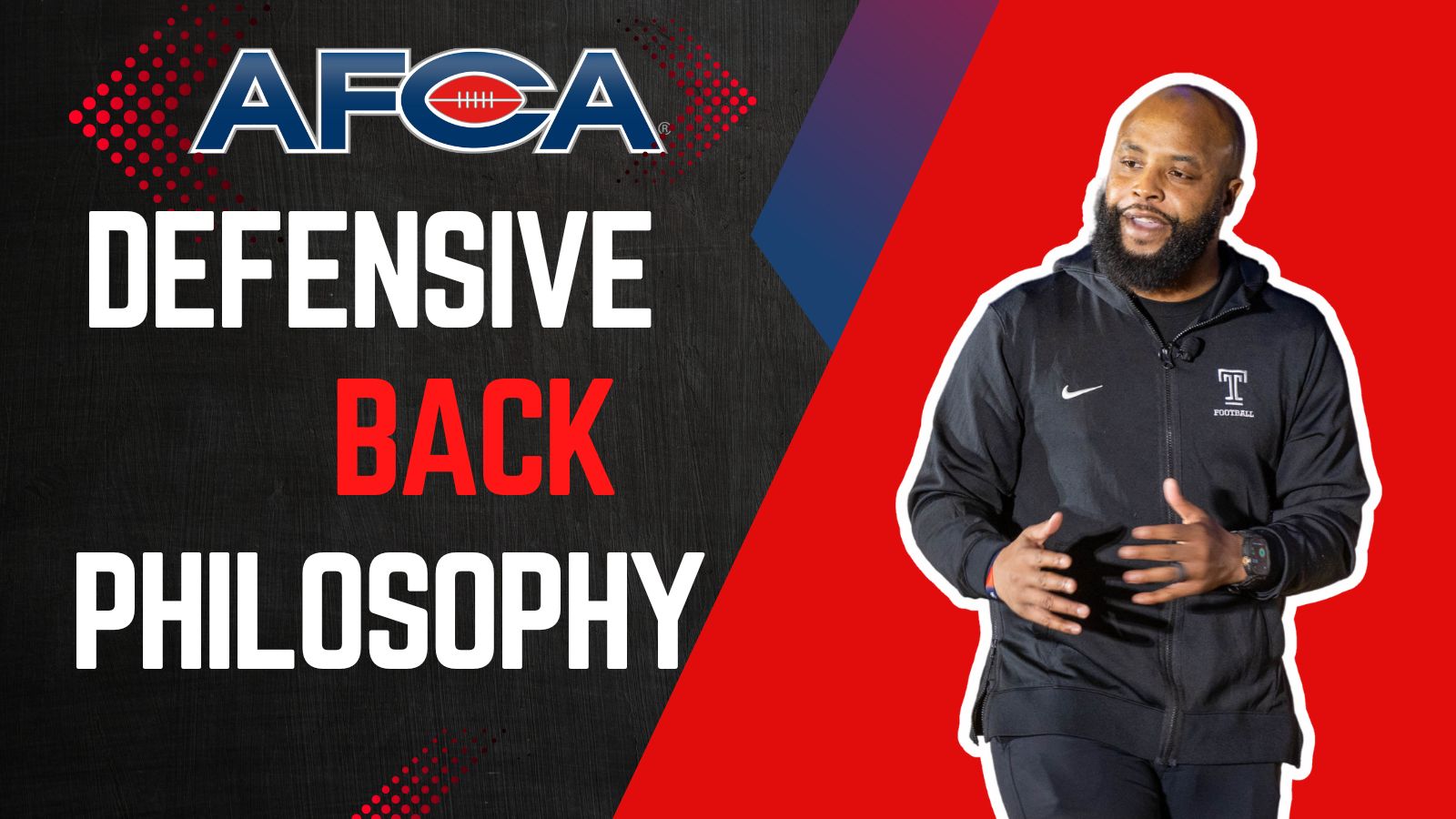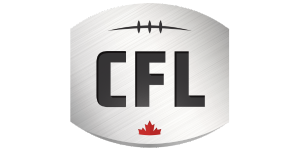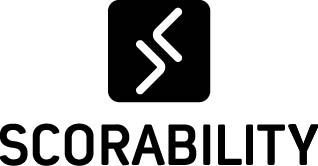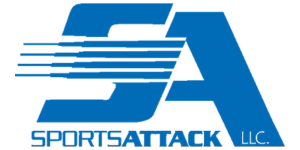
Defensive Back Philosophy
March 11, 2024
2024 AFCA Convention
Guest Speaker: Dominique Bowman, Cornerbacks Coach at Temple
Dominique Bowman is in his second year as cornerbacks coach at Temple University. Bowman, who participated in the AFCA’s 35 under 35 coaches’ leadership initiative in 2020, started his college coaching career in 2016 at Arkansas-Monticello as the defensive backs coach. Over the years, Coach Bowman has been with many different programs where he’s helped coach nationally-ranked defenses.
The Temple Owl’s philosophy is; Be detail-oriented; Be sound in your technique; Be prepared; and Always give maximum effort. We have four non-negotiables for our defensive backs: 1. Beat a block; 2. Make a tackle; 3. Play the ball; 4. Play with confidence. We also have our Defensive Back 10 commandments:
- I will play what I see! My eyes tell me the truth! I will not guess!
- I will never jump routes. My film study and preparation will allow my technique to take me to the ball.
- I will do my job and trust my teammates will do theirs.
- I will make every play that comes to me.
- If I don’t know, I will play the deepest route (top down).
- I will be a complete player and tackle at a high level.
- I will give 100% all of the time.
- I will punish and out compete my opponent.
- I will walk with swagger and play with confidence.
- I will be the standard for how we play.
How we teach progressions is through 6 things: alignment, stance, key, responsibility, technique, and finish. You need to understand your alignment before the play happens and then get in your stance. A stance lets me know that you’re ready to play. You can get in staggered stance, reverse staggered stance, or square stance. Next, you must get your eyes on the key. Responsibility is what you do once your key moves. For the technique to work, both the players and coaches must be bought in. And lastly, you must find a way to make your guys finish plays.
For Indy Philosophy, the focus is on agility, ball drills, and contact. Some examples of agility and ball drills are 4-cone, speed turns, transitions, and 3-cone breaks. When running these drills, remind your players every detail matters.
4-Cone:
- Shoulder over knees, knees over toes
- You want to be in a staggered stance and keep your framework tight
- Point toe, run arms, stay in the framework
- Plan, point drive
- Keep your chin down in transition (your chin is your steering wheel; it controls your entire body)
Transitions:
- Shoulder over knees, knees over toes
- Staggered stance and keep framework tight
- Keep chin down
- Plaint, point drive, run arms
- Keep chin down on the transition
Speed Turns:
- Keep chin down
- Shoot elbows through
- Violent head snap
3-Cone Breaks:
- Great stance
- Plant, point drive
- Chin down and violent out of breaks
Some examples of our contact drills are owl tackle (angled tackle), head up tackle, and block defeats. During these drills, remind your players that your eyes control everything. There are three different ways to beat a block: in phase block defeat, out of phase block defeat, and on the move. Examples of our contact drills below.
Owl Tackle (angle tackle):
- Eyes on inside hip of ball carrier
- Gain around with every step
- Same leg/same shoulder
- Roll hips, run your feet, wrap and squeeze
Head-up Tackle:
- Eyes on the belt line
- Gain ground with every step
- Same leg/same shoulder
- Roll hips, run your feet, wrap and squeeze
Block Defeat – in phase:
- Hands inside the framework
- Eyes at throat level
- Glued knees, keep feet hot
- Violent dishrag defender
Block Defeat – out of phase engage:
- Know where the ball carrier is
- Make sure to own my leverage
- Violent dishrag defender
- Finish in a dominant football position
Block Defeat – out of phase with speed:
- Elbows together
- Be first with shock
- Dishrag defender
- Beat them with speed
Now, let’s talk about man coverage. When in man coverage, you must fight to maintain the frontal position. As the DB, you want to be the one to decide where the receiver goes. When inching back, make sure you remember, if you can’t strike the wideout, then you are too far. With this we have a few options when it comes to coverage, like press man and 1 on 1s. A few man coverage drills are below.
Press Man:
- Basketball shuffle
- Eyes on the belt line
- Shoulder over knees, knees over toes
- On the balls of my feet
- Shuffle to maintain frontal position
Angle Kick :
- Inch back
- Keep square framework
- Cut off at 45 degrees once outside of the framework
1 on 1s:
- The objective is not to let the guy run in a straight line
When working these press man and 1 on 1 drills, instill in your players to get their eyes up and get their elbows above their eyes.
For more information about the AFCA, visit www.AFCA.com. For more interesting articles, check out The Insider and subscribe to our weekly email.
If you are interested in more in-depth articles and videos, please become an AFCA member. You can find out more information about membership and specific member benefits on the AFCA Membership Overview page. If you are ready to join, please fill out the AFCA Membership Application.
« « Previous PostNext Post » »
2024 AFCA Convention
Guest Speaker: Dominique Bowman, Cornerbacks Coach at Temple
Dominique Bowman is in his second year as cornerbacks coach at Temple University. Bowman, who participated in the AFCA’s 35 under 35 coaches’ leadership initiative in 2020, started his college coaching career in 2016 at Arkansas-Monticello as the defensive backs coach. Over the years, Coach Bowman has been with many different programs where he’s helped coach nationally-ranked defenses.
The Temple Owl’s philosophy is; Be detail-oriented; Be sound in your technique; Be prepared; and Always give maximum effort. We have four non-negotiables for our defensive backs: 1. Beat a block; 2. Make a tackle; 3. Play the ball; 4. Play with confidence. We also have our Defensive Back 10 commandments:
- I will play what I see! My eyes tell me the truth! I will not guess!
- I will never jump routes. My film study and preparation will allow my technique to take me to the ball.
- I will do my job and trust my teammates will do theirs.
- I will make every play that comes to me.
- If I don’t know, I will play the deepest route (top down).
- I will be a complete player and tackle at a high level.
- I will give 100% all of the time.
- I will punish and out compete my opponent.
- I will walk with swagger and play with confidence.
- I will be the standard for how we play.
How we teach progressions is through 6 things: alignment, stance, key, responsibility, technique, and finish. You need to understand your alignment before the play happens and then get in your stance. A stance lets me know that you’re ready to play. You can get in staggered stance, reverse staggered stance, or square stance. Next, you must get your eyes on the key. Responsibility is what you do once your key moves. For the technique to work, both the players and coaches must be bought in. And lastly, you must find a way to make your guys finish plays.
For Indy Philosophy, the focus is on agility, ball drills, and contact. Some examples of agility and ball drills are 4-cone, speed turns, transitions, and 3-cone breaks. When running these drills, remind your players every detail matters.
4-Cone:
- Shoulder over knees, knees over toes
- You want to be in a staggered stance and keep your framework tight
- Point toe, run arms, stay in the framework
- Plan, point drive
- Keep your chin down in transition (your chin is your steering wheel; it controls your entire body)
Transitions:
- Shoulder over knees, knees over toes
- Staggered stance and keep framework tight
- Keep chin down
- Plaint, point drive, run arms
- Keep chin down on the transition
Speed Turns:
- Keep chin down
- Shoot elbows through
- Violent head snap
3-Cone Breaks:
- Great stance
- Plant, point drive
- Chin down and violent out of breaks
Some examples of our contact drills are owl tackle (angled tackle), head up tackle, and block defeats. During these drills, remind your players that your eyes control everything. There are three different ways to beat a block: in phase block defeat, out of phase block defeat, and on the move. Examples of our contact drills below.
Owl Tackle (angle tackle):
- Eyes on inside hip of ball carrier
- Gain around with every step
- Same leg/same shoulder
- Roll hips, run your feet, wrap and squeeze
Head-up Tackle:
- Eyes on the belt line
- Gain ground with every step
- Same leg/same shoulder
- Roll hips, run your feet, wrap and squeeze
Block Defeat – in phase:
- Hands inside the framework
- Eyes at throat level
- Glued knees, keep feet hot
- Violent dishrag defender
Block Defeat – out of phase engage:
- Know where the ball carrier is
- Make sure to own my leverage
- Violent dishrag defender
- Finish in a dominant football position
Block Defeat – out of phase with speed:
- Elbows together
- Be first with shock
- Dishrag defender
- Beat them with speed
Now, let’s talk about man coverage. When in man coverage, you must fight to maintain the frontal position. As the DB, you want to be the one to decide where the receiver goes. When inching back, make sure you remember, if you can’t strike the wideout, then you are too far. With this we have a few options when it comes to coverage, like press man and 1 on 1s. A few man coverage drills are below.
Press Man:
- Basketball shuffle
- Eyes on the belt line
- Shoulder over knees, knees over toes
- On the balls of my feet
- Shuffle to maintain frontal position
Angle Kick :
- Inch back
- Keep square framework
- Cut off at 45 degrees once outside of the framework
1 on 1s:
- The objective is not to let the guy run in a straight line
When working these press man and 1 on 1 drills, instill in your players to get their eyes up and get their elbows above their eyes.
For more information about the AFCA, visit www.AFCA.com. For more interesting articles, check out The Insider and subscribe to our weekly email.
If you are interested in more in-depth articles and videos, please become an AFCA member. You can find out more information about membership and specific member benefits on the AFCA Membership Overview page. If you are ready to join, please fill out the AFCA Membership Application.

















